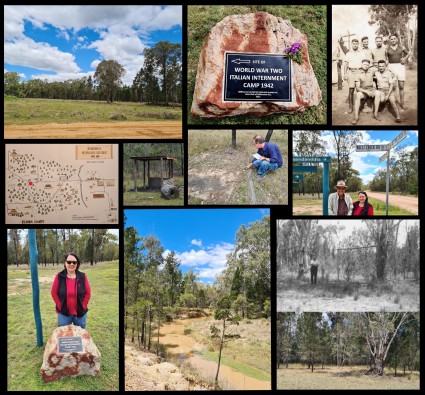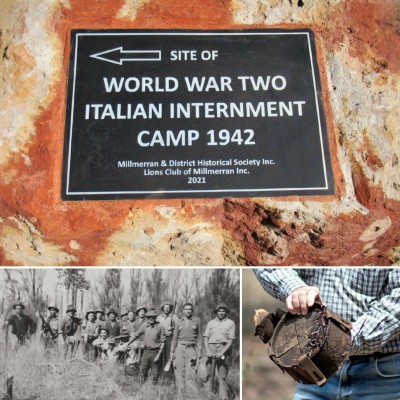It’s been almost a decade since I headed to Millmerran and Western Creek with Roger to try and find the internment camp where ‘Joe’, Nonno Anni and many other Italian men were held in 1942. Back then, hardly anyone knew of the camp, either authorities or locals, and to find its location I was relying on my grandfather’s memories from decades before and scant information I’d been able to garner. For those who’ve read, Joe’s Fruit Shop and Milk Bar, you may recall I stopped at a spot out at Western Creek largely on a ‘feeling’. It seems absurd, I know, and hardly scientific. However, since then, more research and investigating has been done by others to locate the camp site and I can hardly believe it but the spot I had a feeling about ended up being the exact right location. So wonderful to discover this (and a bit spooky too perhaps!)

Clockwise from top left: Location of the internment camp Western Creek, the memorial stone, internees in 1942 (Nonno Anni standing on right), with Cec at the crossroads near the camp, Nonno Anni there in 1964 and the possible spot now, Western Creek, at the memorial stone, red dot marks the spot. And centre: Roger at the galley cook area find, and how it would’ve looked based on a similar one from the era still standing.
The second discovery we made was while walking around and deeper into the site, this time in search for where Nonno Anni had his photo taken when he returned there in 1964. I’m not convinced we found exactly where he stood, even though there was a stump where the other tree behind him had been, but nearby, we made a new discovery, the concrete slab where the crude, galley cooking area of corrugated iron had been. Again, by chance.
To return to this location, now confirmed, on the 80th anniversary that the internment camp was there, felt very special. I’d been invited to speak at an event for this back in May but it was cancelled due to rain and I felt sad in not being able to honour the internees that day. I’d vowed to still return to the site anyway when I could, just quietly, and I picked some nearby wildflowers (and weeds – but pretty!) and left them at the memorial stone that now marks the site.
It was lovely to share this moment with both Roger and also Cecil Gibson, born and of Millmerran and Western Creek for all of his 86 years. While others later became involved, for which I’m very thankful, Cec deserves special mention because he was the first local to pick up on this hidden history after reading about it in, Joe’s Fruit Shop and Milk Bar, and to contact me. He remained focussed on honouring the history both at the site and the Millmerran Museum, even when much seemed against him at times.
The first internment camps in Australia were established under the Menzies government in 1940 and most of these were full by the time the war really ramped up in 1942 and the ‘overflow’ of ‘enemy aliens’ were interned in unofficial and secret camps in isolated state forest and bushland. While other countries like Canada apologised to its Italian-Canadian WW2 internees in 2021 and the U.S.A. has introduced a Bill towards doing so, Australia remains silent on this. And sadly, most Italian-Australian internees are no longer able to receive an apology. That doesn’t mean it’s not important also for their descendants though and all those others who care deeply for their local history.
To write about this internment camp and what happened to Italian-Australians in the 20th century is the most important part of what I’m fortunate to do. And I don’t think the people of Millmerran were given enough credit with the camp being kept secret from them for so long. All of those I’ve spoken to from the area have had nothing but respect, acceptance and the will to help preserve this history and for that I’ll always be grateful. Zoë x
Thank you if you read until the very end! 😊 I just couldn’t skimp on this one. 💛 xx

 Minted in Australia during WW2 and officially referred to as tokens, the coins were struck in five denominations – penny, threepence, one, two and five shillings, which couldn’t be used or redeemed outside a camp. Some internees in various camps created their own currency including paper money but the Australian Department of Army distributed tokens such as this one for official camp use. (This penny was struck by R. Arendeen & Sons Pty Ltd in Malvern, Victoria. The coin dies now owned by the Royal Australian Mint.)
Minted in Australia during WW2 and officially referred to as tokens, the coins were struck in five denominations – penny, threepence, one, two and five shillings, which couldn’t be used or redeemed outside a camp. Some internees in various camps created their own currency including paper money but the Australian Department of Army distributed tokens such as this one for official camp use. (This penny was struck by R. Arendeen & Sons Pty Ltd in Malvern, Victoria. The coin dies now owned by the Royal Australian Mint.) It seems incredible it’s eighty years since March, 1942 when Annibale (Joe), aged only eighteen, saw dozens of Italian men picked up by police while working on farms around the Stanthorpe area. The only reason he wasn’t arrested on the spot too that day being his cheekily having fled from Ingham to avoid internment without notifying authorities of his change of address as required, but once they saw him among the others the game was up and he had to go in. How it must have felt to be taken away in the ‘internee special’ train not knowing where to, then driven around in army trucks for hours in the dead of night to confuse their whereabouts to end up in a camp seemingly in the middle of nowhere surrounded by bushland.
It seems incredible it’s eighty years since March, 1942 when Annibale (Joe), aged only eighteen, saw dozens of Italian men picked up by police while working on farms around the Stanthorpe area. The only reason he wasn’t arrested on the spot too that day being his cheekily having fled from Ingham to avoid internment without notifying authorities of his change of address as required, but once they saw him among the others the game was up and he had to go in. How it must have felt to be taken away in the ‘internee special’ train not knowing where to, then driven around in army trucks for hours in the dead of night to confuse their whereabouts to end up in a camp seemingly in the middle of nowhere surrounded by bushland. My grandpa, Bob and my grandma, Lorna met there in the 1940s when each of them were stationed in Darwin, he in the air force, she in the WNELs (Women’s National Emergency Legion), being among those involved in its clean-up and recovery. These bombings also meant the ramping up of interning Italian ‘aliens’, Nonno Anni being one of those rounded up soon after as a result of what happened in Darwin.
My grandpa, Bob and my grandma, Lorna met there in the 1940s when each of them were stationed in Darwin, he in the air force, she in the WNELs (Women’s National Emergency Legion), being among those involved in its clean-up and recovery. These bombings also meant the ramping up of interning Italian ‘aliens’, Nonno Anni being one of those rounded up soon after as a result of what happened in Darwin. A memorial stone and plaque are now in place at the site of the secret internment camp at Western Creek. It’s been quite a twisting trail to get to this point – from writing about my grandfather being an internee there in
A memorial stone and plaque are now in place at the site of the secret internment camp at Western Creek. It’s been quite a twisting trail to get to this point – from writing about my grandfather being an internee there in  When I wrote about the secret internment camp at Western Creek in Joe’s Fruit Shop and Milk Bar, I thought that was the end of it. It took several years and almost a detective hunt to put together the information and I met many brick walls from authorities. Some refused to believe the camp that detained hundreds of innocent men during WW2 even existed, others conceded that records for such camps were often scant and, in the years afterward, destroyed. Or not kept at all. (These camps being relatively secret and hidden out in Queensland’s west in forest or bushland when official internment camps at places like Enoggera were full.)
When I wrote about the secret internment camp at Western Creek in Joe’s Fruit Shop and Milk Bar, I thought that was the end of it. It took several years and almost a detective hunt to put together the information and I met many brick walls from authorities. Some refused to believe the camp that detained hundreds of innocent men during WW2 even existed, others conceded that records for such camps were often scant and, in the years afterward, destroyed. Or not kept at all. (These camps being relatively secret and hidden out in Queensland’s west in forest or bushland when official internment camps at places like Enoggera were full.) To me, it’s both remiss and insensitive that internees in Australia weren’t given some type of official apology like those in other countries were and, of course, for most it is too late now to hear one. Nonno Anni never bore any bitterness or ill will for his internment, he accepted it with grace as a factor of wartime, but I hope remembering what happened in this way gives back a little of what was lost.
To me, it’s both remiss and insensitive that internees in Australia weren’t given some type of official apology like those in other countries were and, of course, for most it is too late now to hear one. Nonno Anni never bore any bitterness or ill will for his internment, he accepted it with grace as a factor of wartime, but I hope remembering what happened in this way gives back a little of what was lost.